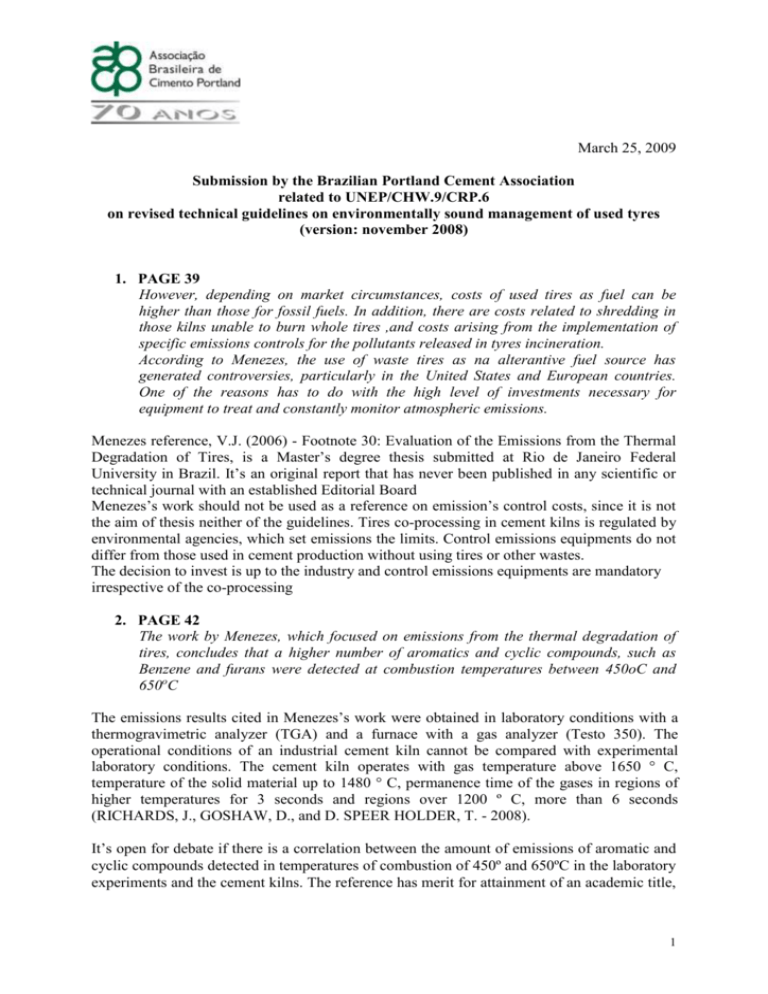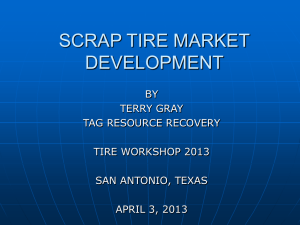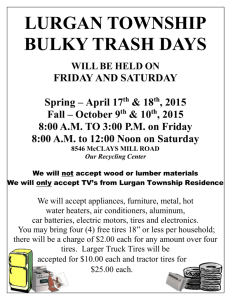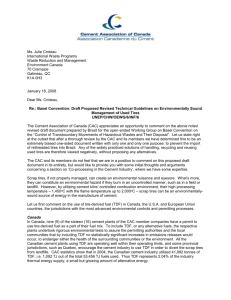A Convenção de Estocolmo, recentemente
advertisement

March 25, 2009 Submission by the Brazilian Portland Cement Association related to UNEP/CHW.9/CRP.6 on revised technical guidelines on environmentally sound management of used tyres (version: november 2008) 1. PAGE 39 However, depending on market circumstances, costs of used tires as fuel can be higher than those for fossil fuels. In addition, there are costs related to shredding in those kilns unable to burn whole tires ,and costs arising from the implementation of specific emissions controls for the pollutants released in tyres incineration. According to Menezes, the use of waste tires as na alterantive fuel source has generated controversies, particularly in the United States and European countries. One of the reasons has to do with the high level of investments necessary for equipment to treat and constantly monitor atmospheric emissions. Menezes reference, V.J. (2006) - Footnote 30: Evaluation of the Emissions from the Thermal Degradation of Tires, is a Master’s degree thesis submitted at Rio de Janeiro Federal University in Brazil. It’s an original report that has never been published in any scientific or technical journal with an established Editorial Board Menezes’s work should not be used as a reference on emission’s control costs, since it is not the aim of thesis neither of the guidelines. Tires co-processing in cement kilns is regulated by environmental agencies, which set emissions the limits. Control emissions equipments do not differ from those used in cement production without using tires or other wastes. The decision to invest is up to the industry and control emissions equipments are mandatory irrespective of the co-processing 2. PAGE 42 The work by Menezes, which focused on emissions from the thermal degradation of tires, concludes that a higher number of aromatics and cyclic compounds, such as Benzene and furans were detected at combustion temperatures between 450oC and 650oC The emissions results cited in Menezes’s work were obtained in laboratory conditions with a thermogravimetric analyzer (TGA) and a furnace with a gas analyzer (Testo 350). The operational conditions of an industrial cement kiln cannot be compared with experimental laboratory conditions. The cement kiln operates with gas temperature above 1650 ° C, temperature of the solid material up to 1480 ° C, permanence time of the gases in regions of higher temperatures for 3 seconds and regions over 1200 º C, more than 6 seconds (RICHARDS, J., GOSHAW, D., and D. SPEER HOLDER, T. - 2008). It’s open for debate if there is a correlation between the amount of emissions of aromatic and cyclic compounds detected in temperatures of combustion of 450º and 650ºC in the laboratory experiments and the cement kilns. The reference has merit for attainment of an academic title, 1 but should not be used as a technical reference of UNEP Guidelines. It is therefore recommended the withdrawal of the reference in the text of the document. 3. PAGE 39 - 40 Data on emission during co-processing of tyres in cement kilns are controversial. Proponents of TDF argue that, with correct techniques and equipment, the combustion of tyres and other wastes is no different than coal combustion. However, the data avaible do not always support this argument. Researches at the Okopol Institut fur Okologiie und Politik, in Germany, concluded that “incineration of tyres significantly raises inputs of zinc and lead into a cement kiln and also causes between a two-fold and a five-fold increase of dioxin emissions” Tires co-processing was not the aim of the cited paper (reference 32 – Joachim Lohse & Jan Wulf-Schnabel, Okopol Institut fur Okologie und Politik GmbH, "Expertise on the Environmental Risk Associated with Co-Incineration of Wastes in Cement Kiln - “Four E” of CBR Usine de Lixhe, Belgium). The work is a critical evaluation of environmental impact assessment (EIA) of “Resofuel” co-processing in a Belgian cement producer requested by the Green Peace to Okopol Institute The conclusion presented on the increase emissions with co-processing tires is not based on data obtained from measurements but, on other german studies cited as references (Winkler 1992, Fiz/Lahmeyer, 1993, ITU, 1994) http://www.oekopol.de/de/Archiv/Anlagenbezoger%20US/CBRBelgien/cbrBelgien.pdf PÁGE 40 In a study conducted for the state of California, Professor Seymour Schwartz of the University of California examined four cement kilns while burning up to 20% of tyres and reported the following results: 1. Dioxins and furans increased between 53% and 100% in 4 of 4 tests 2. PAH’s increased between 296% and 2230% in 3 of 4 tests 3. Lead increased between 59% and 475% in 3 of 4 tests 4. Chromium increased 727% in one test, with much smaller decreases in others 5. Only the emissions of nitrogen and the sulfur oxides showed better results. Professor. Schwartz’s report (reference 33) does not present the actual data which the calculated percentages were based, nor if the values obtained reach the local standards emissions. Additionally a universe of four furnaces is not representative. http://www.energyjustice.net/tires/files/attacha-health-risk.pdf It is suggested to withdraw the reference or to refer to recent studies and more reliable data. In a study published in 2008 by the PCA, Portland Cement Association, results of 258 measurements of dioxins and furans in furnaces with and without the use of tires, have indicated that kilns firing tires had emissions emissions approximately one-third of those burning conventional fuels such as coke , coal and natural gas. In the case of hydrocarbons, 29 tests values have been included in the study, showing a slight increase, around 30% on average, when burning tires. Regarding metal emissions, they are affected by many factors, like the amount of metal fed with the raw materials and fuels, as well as its volatility. 2 PCA - Portland Cement Association Air Emissions Data Summary for Portland Cement Pyroprocessing Operations Fire TireDerived Fuels, SN3050, Portland Cement Association, Skokie, Illinois, USA, 2008, 32 pages – http://www.cement.org/bookstore/profile.asp?itemid=SN3050 4. PÁGE 43 Over the last two years, an increasing active participation of groups that are opposed the licensing of tyre co-processing in cement kilns has resulted in the elimination of TDF as alternative fuel in five plants in the United States, and a halt in the licensing process of four others. According to the cited reference (U.S. Scrap Tire Markets 2003/2004 edition), at the end of 1998, 30 facilities were using TDF, consuming 38 million tires. At the end of 2001, were 39 facilities burning tires (62 kilns) using 53 million tires. At the end of 2003, 43 facilities (65 kilns) were permitted to use TDF and consumed 53 million tires. The stability of TDF consumption by the cement industry was due to several factors: • kilns operating at less than full capacity (kilns with high demand for cement often do not use TDF because TDF can limit kiln capacity) • rising cost of the energy, • favorable cost implications • reduction of NOx emissions • TDF usage has become a routine practice. The most recent report (Scrap Tire Markets in the United States - 2005/2006 edition) presents the data of co-processed tires in 2005 in the U.S. in a total of 58 million units in 78 cement kilns. The data presented at the report, show an increase in TDF consumption by the cement industry as well as the number of kilns permitted. https://www.rma.org/publications/scrap_tires 5. PAGE 43 The guideline besides listing available techniques for environmentally sound management of used tires, should point out their advantages, so we suggest include before item III (Coprocessing in Plants for Electric Power Generation): Advantages of burning tires in cement kilns: •Co-processing tires in cement kilns is one of the most effective technologies for destruction of large volumes of scrap tires • Reduction of fossil fuel consumption and reduction of CO2 emissions resulting from the presence of a fraction of natural rubber (biomass) in tires • No generation of other waste (ash). The ash produced by the combustion of the tires becomes an integral component of the product. • Activity regulated and controlled by state and federal agencies • NOx emissions reduction • Efficient way to avoid the Aedes Aegypti spread (Dengue’s mosquito) Yushiro Kihara Technology Manager Brazilian Portland Cement Association 3






